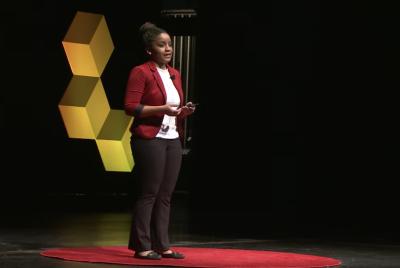Lecturer Jasmine Roberts always loved the Big Ten spirit. After graduating from Ohio State’s rival, the University of Michigan, and attending the University of Illinois to pursue her PhD, Roberts put her doctoral work on hold and came to Columbus in search of new job opportunities. She now serves as a lecturer of strategic communication, teaching students and advising the National Association for Black Journalists chapter at Ohio State.
“It’s the perfect fusion between what I like to do in the private sector with marketing and public relations as well as in academia with teaching,” Roberts said.
Roberts teaches Writing for Strategic Communications and Public Communication Campaigns. She is also the author of a free open source textbook called “Writing for Strategic Communication Industries.”
The campaigns course combines what students learn throughout their education in the School of Communication and applies it in a capstone class where students work with a real-world business.
“It is nice to see the progress from students to young professionals in this class,” Roberts said.
After professional experience in marketing and public relations and eight years of teaching at The Ohio State University, an important piece of advice that Roberts has for her students is that leading with empathy will really take you far in this industry.
“Half of marketing and PR is empathy,” she said. “You have to be able to tell a story that’s engaging and really meets people where they are, on an empathetic level.”
Roberts is also a strong advocate for racial justice and equity within the School of Communication and Ohio State. She worked with students and founded an Ohio State chapter of NABJ in 2019 and now serves as its faculty advisor. She is also a Second-Year Transformational Experience mentor for women of color.

Roberts delivered a TED talk last year called “I’m tired of talking about race” where she discussed the emotional fatigue experienced by people of color when discussing race with their white counterparts, coupled with solutions to this growing concern. Her article titled “White Academia: Do Better” appeared on Medium.com with nearly 170,000 views, and she also received a $500 grant from The Ohio State University's Affordable Learning Exchange to help students learn more about racial disparities and injustices. Some of the criteria for the project included adding a racial justice component in the syllabus for one course and creating resources for students, including a reading list that cites Black authors. None of these additions to course material can add an expense to students taking the class.
Roberts is also part of an interdisciplinary team at Ohio State that was awarded a $25,000 grant from the university’s Seed Fund for Racial Justice with a $25,000 match from the Global Arts + Humanities Discovery Theme to conduct the first comprehensive historical study of Black mathematicians at a single U.S. institution.
Roberts said the most important thing to her is that she shows up as human to her students, and as a result, they show up as human to her. This creates an overall more positive classroom experience.
“I am most proud that I created a comfortable environment and my students feel like they could just be,” Roberts said.
Classroom comfort and teacher approachability is especially important now because teachers and students need to adjust quickly to new ways of learning, due to the pandemic.
“It is my hope in academia that because of the pandemic, we are able to use more of a human first approach in everything that we do,” Roberts said. “It shouldn’t take a pandemic for people to see each other as human.”
Article by student Brianna Quadrozzi
